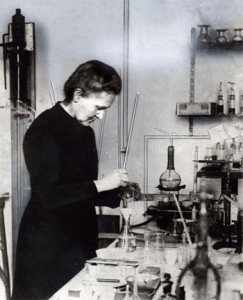
The other day I started thinking about heroes and it occurred to me that we rarely speak about science heroes so I decided to write a blog post about it and asked those on twitter to supply their #scienceheroes. Due to the large number of #scienceheroes I decided to give each hero or heroine their own post.
As a very young girl, about 7, I read a book about another little girl who was quiet and studious, she would get so focused she would shut out the outside world and despite all the odds against her she became a scientist, received her PhD, and two Noble Prizes, fell in love, got married, and had two children. She did not set out to change the world, she merely wanted to be herself, but Marie Curie changed the world and has inspired generations of women in science.
Madam Curie, was born Marie Skodowska on November 7, 1867 in Warsaw, Poland (at that time it was controlled by the Russian Czar). She graduated from high school at 15 and, after a year off for her health, attended underground classes with her sister to further her education. Working and taking illegal classes (Russia did not allow laboratory studies by Polish citizens, and women were not allowed to go to university) at age 24 she had saved enough money to go to Paris.
Marie registered as Maria Sklodowska and through hard work made up for her lack of formal higher education, taking only three years to complete her master’s degree in physics and math. Winning a scholarship she began examining magnetic forces which led to her meeting Pierre Curie, her future husband.? In 1887 Marie gave birth to their first of two children and began looking for a doctoral research project. This led to her ground breaking work with uranium and other radio-active compounds.? Like most scientists the Curies never grew rich for their research, as @gimpyblog said in today’s science discussions on twitter, “Worth noting scientists rarely call for increased pay, unlike bankers and CEOs, but for funds enabling them to do a better job”.
In 1903 Marie became the first woman in France to receive a PhD in Science and shared the Noble prize in Physics with her husband and research partner Pierre Curie.? When both Pierre and Marie started working at the Sorbonne, Pierre as a professor, Marie as a laboratory chief things were looking up until 1906 when Pierre was accidentally killed by a horsedrawn carriage. Marie was devastated but returned to work the day after the funeral, a month later she was promoted to Pierre’s position as full professor. Through heavy lobbying she founded the Radium Institute in Pierre’s memory.
In 1911 Marie won a second Nobel Prize in Chemistry for her discovery of radium and polonium. During World War I Marie was designed and raised funds and supplies for the first mobile x-ray stations in an effort to save lives, and later devised the beginnings of chemo-therapy. A clever and thoughtful woman Marie used her fame to raise funds after the war to fund further research and expansion of the Radium Institute.
On July 4, 1934 Madame Marie Curie died, most likely as a result of complications from long term radiation poisoning. She was buried next to Pierre, and they were both later moved to the Pantheon in Rome.
For more information about Marie’s life check out the American Institute of Physics online exhibit:
http://www.aip.org/history/curie/contents.htm
Marie Curie was my first Science Heroine, who are some of your Science Heroes?
